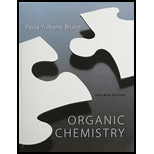
Concept explainers
Interpretation:
For the given enzyme catalyzed reaction, the given reactant undergoes
Concept introduction:
Nucleophile: Nucleophiles are electron rich compounds which donates electrons to electrophilic compounds which results in bond formation.
Nucleophilic nature depends on the negative charge present in the molecule, the solvent in which it present and the electronegativity of the atom.
Electrophile: Electrophiles are electron deficient compounds which accepts electrons from nucleophiles that results in bond formation.
The curved arrows are generally used to indicate the flow of electrons present in the reaction.
Ozonolysis Reaction: It is an oxidative reaction which is used to oxidize the carbon-carbon double and triple bond.
Oxidation Reaction: It involves loss of electrons, addition of oxygen atoms or removal of hydrogen atoms.
Reduction Reaction: It is just opposite of oxidation reaction which involves removal of oxygen atoms or addition of hydrogen atoms and addition of electrons.
Addition Reaction: It is defined as chemical reaction in which two given molecules combines and forms product. The types of addition reactions are electrophilic addition, nucleophilic addition, free radical additions and cycloadditions. Generally, compounds with carbon-hetero atom bonds favors addition reaction.
In addition reaction of
Geometric isomers: Two compounds are considered as geometric isomers of each other if both contains same number of atoms but different in their arrangement that is compound is regarded as cis if identical substituents are placed on same side and trans if they are placed on the opposite sides.
Erythro product: It is the representation of carbohydrates in Fischer projection when two same substituents are placed on the same side.
Want to see the full answer?
Check out a sample textbook solution
Chapter 6 Solutions
Organic Chemistry & Study Guide and Student Solutions Manual for Organic Chemistry, Books a la Carte Edition (7th Edition)
- Explain why the alkyl halide shown here reacts much more rapidly with guanine than does a primary alkyl halide (such as pentyl chloride). The alkyl halide can react with two guanines, each in a different DNA chain, thereby cross-linking the chains. Propose a mechanism for the cross-linking reaction.arrow_forwardDraw the products of attached SN2 reaction and indicate the stereochemistrywhere appropriate.arrow_forwardWhich reaction below give a par of diastereomers and Why?arrow_forward
- Draw the mechanism of the following reaction and label the RDS.arrow_forwardThe -NHCOCH3 group is considered a .... Ortho/Para Directing Activator Ortho/Para Directing Deactivator Meta Directing Deactivatorarrow_forwardDraw the structure of the product, substrate, or condition in the following reactions. Clearly show the stereochemistry.arrow_forward
- Draw the product of this reaction and states its IUPAC name, and states what type of mechanism is occuring (eg. SN1, SN2, E1, E2, etc)?arrow_forwardFor each section, circle the mechanism from the two options given (SN1 or SN2) and draw the main organic product resulting from that mechanism. Indicate the stereochemistry and if two configurational isomers form, draw both.arrow_forwardA. Arrange the following radicals in order of decreasing rate of bromination. Justify your answer. B. Trehalose and isomaltose are both dimers of glucose. However, they have considerablydifferent reactivities. Concisely explain why these differences are observed. -Isomaltose is a reducing sugar while trehalose is not.-Trehalose is very resistant to acid hydrolysis while isomaltose can be acid-hydrolyzed withease.arrow_forward
- The following SN2 reaction gave J as a major product. Determine the structure of J. Explain your answer.arrow_forwardepi-Artistolochene, a hydrocarbon found in both pepper and tabacco, is biologically synthesized by the follwing pathway. Add curved arrows to show the mechanism of each steparrow_forwardCan you explain the mechanism? Can you provide a shortcut?arrow_forward
 Organic Chemistry: A Guided InquiryChemistryISBN:9780618974122Author:Andrei StraumanisPublisher:Cengage Learning
Organic Chemistry: A Guided InquiryChemistryISBN:9780618974122Author:Andrei StraumanisPublisher:Cengage Learning

